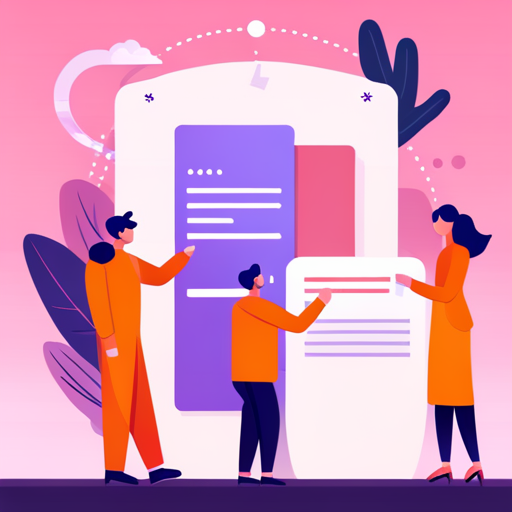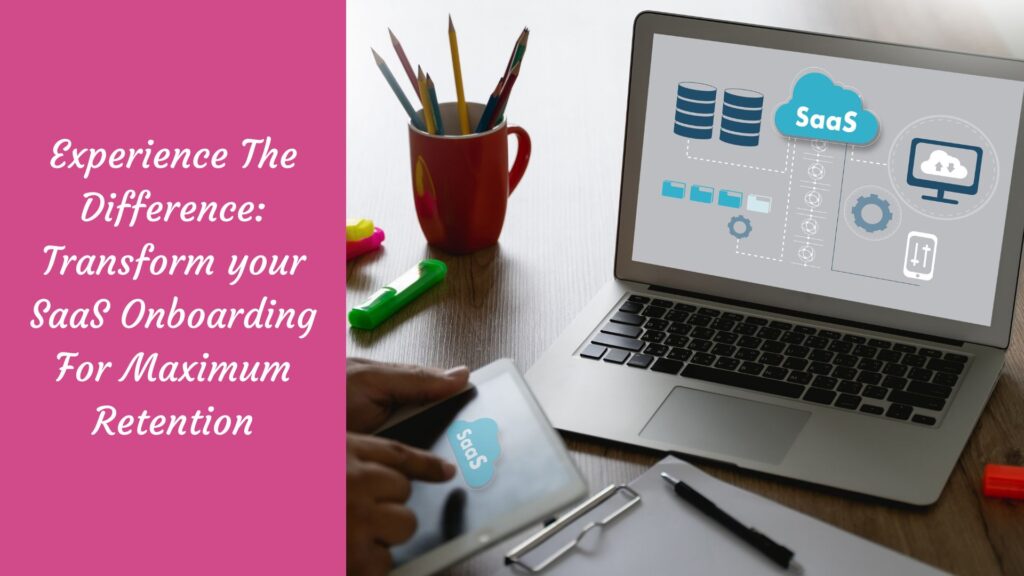Greetings, fellow SaaS owners and operators!
Looking for ways to increase your customer retention rates and boost your profits? Then you’re in the right place!
In this blog post, we’re going to talk about one of the most overlooked yet critical aspects of SaaS business – onboarding.
By the time you finish reading this, you’ll have gained invaluable insights on how to turn your SaaS onboarding process from dull and tedious into a memorable and experience the difference that your users will love. So let’s get started!
What is SaaS Onboarding?
In essence, SaaS Onboarding is the process through which your new users become acquainted with your software. It’s the first real interaction they have with your product, and as the saying goes, “You never get a second chance to make a first impression.” Now, how can you, as a SaaS provider, make your users experience the difference?

Take the example of a CRM software. A typical onboarding process may involve a simple walkthrough of the features, maybe a few tooltip hints here and there. But imagine adding a personal touch to it.
Setting up a one-on-one consultation with the new user, understanding their needs, and customizing the software to their specifications. As if that’s not enough, consider sending them a friendly welcome email and offering a virtual tour guided by an actual human being. Adding a personal touch will not just make customers feel special, but also show that you genuinely care about their needs and are willing to go the extra mile for their satisfaction.
In another scenario, let’s say your product is an innovative graphic design software. Instead of bombarding your new users with all the nifty features at once, consider revealing them as the user progresses with their design.
For instance, when they decide to add text to their design, that’s when you introduce your range of unique fonts. When they plan to add an image, introduce your collection of filters. This “just in time” information will make the onboarding process feel less overwhelming and more tailored to your user’s needs, thus making a significant impact on the overall user experience the difference.
By rethinking and reshaping your onboarding process in ways such as these, you can genuinely make your users “experience the difference.”

SaaS Onboarding is:
- The process that new users or customers go through to get started with your software as a Service (SaaS) product. For example, when you first sign up for a Dropbox account, you’re guided through a series of steps to upload your first file, share it with others, and sync it across your devices. This is the onboarding process.
- The user’s initial experience the difference with your software. For instance, when using the project management tool Asana for the first time, you would be introduced to the features and functionalities through an interactive tutorial. This initial interaction aimed at setting users up for success is part of the onboarding process.
- A way to reduce churn and increase customer lifetime value. For example, a cloud-based CRM software like Salesforce might provide personalized onboarding sessions to new clients to ensure they understand how to effectively use the platform. This can help customers feel more confident and involved, thus increasing their likelihood of remaining subscribed.
- An opportunity to set the tone for the entire customer journey. For example, suppose a user’s onboarding Experience the difference with a photo editing app like Adobe Lightroom is smooth and enjoyable. In that case, they will likely anticipate a positive overall user experience. On the other hand, if the onboarding process is confusing and frustrating, users may have lower expectations for the rest of their interactions with the product.
What is Usability and User Experience testing and how users can experience the difference with it?

- Usability and User Experience testing evaluates products or services through testing with representative users.For instance, Amazon might conduct usability tests to examine how easy it is for shoppers to find a product, add it to their cart, and complete a purchase.

- It involves tasks such as measuring a user’s ability to complete the task, the time it takes to complete the tasks, the user’s satisfaction with the product, etc. For example, a music streaming app like Spotify may test how quickly and easily users can create a playlist or find new songs.
- User Experience testing is crucial for assessing how satisfying or easy a product is to use. A company like Uber might use UX testing to understand the overall experience, from requesting a ride and interacting with the driver to paying and rating the ride.
- This type of testing helps identify issues and areas of improvement in the product or service. Twitter, for example, might conduct usability tests to determine if new users understand the concept of ‘retweeting’ or ‘threading tweets.’
- Usability and User Experience testing improves customer experience, leading to higher loyalty and conversion rates. For example, if a fitness app like Fitbit tests and enhances user experience, customers are more likely to continue using it, boosting retention. Here is a comparison table for a clear view:
| Topic | Usability Testing | User Experience Testing |
|---|---|---|
| Purpose | Evaluate the usability of a product or service | Gather feedback on user experience and preferences |
| Focus | Focuses on the ease of use, efficiency, and learnability | Emphasizing the holistic user experience and striving for utmost satisfaction. |
| Scope | Evaluates specific usability issues and tasks | Collects broader feedback on the entire user journey |
| Method | Used to identify and address user issues | Used to gather insights for iterative improvements |
| Goal | Identify and resolve usability issues and pain points | Understand user needs, preferences, and behaviors |
7 Common Problems with SaaS Onboarding
- Lack of Clear Instructions: Some SaaS platforms fail to provide clear and concise steps to guide users through their initial interactions. For instance, a user starting with Slack might feel overwhelmed if not properly guided on how to create channels, add members, and integrate other tools.

- Too Much Information at Once: Overwhelming users with excessive information during the initial stages can be counterproductive. A new user of Google Analytics, for instance, could be inundated by the vast amount of data and metrics presented without proper context or guidance.
- Not Personalized: Onboarding that doesn’t cater to the specific needs and expectations of the user can lead to dissatisfaction. For example, a small business using Salesforce might not need all of its complex features intended for larger enterprises and may feel lost or overwhelmed.
- Technical Difficulties: Glitches, slow load times, and broken features can make onboarding frustrating. A new user trying to upload their first file on Dropbox, for example, would not have a favorable impression if the upload fails repeatedly.
- No Feedback Mechanism: Without an efficient way to voice concerns or report problems, users can feel ignored. For example, a newbie on Asana might encounter a problem but find no easy way to relay the issue back to the support team.
- Insufficient Follow-up Support: If users are left on their own after the initial onboarding, they can run into difficulties. For instance, a user of Adobe Lightroom may need additional help figuring out advanced features after mastering the basics.
- Disjointed User Experience: If the onboarding experience doesn’t align with the overall look, feel, and functionality of the software, it can cause confusion. A user might feel jolted, for example, if transitioning from a sleek, easy-to-navigate onboarding tutorial into a cluttered and confusing main interface.
How to Create an Unforgettable Onboarding Experience
Now, onto the fun part – how to create an onboarding experience that your users will remember and cherish forever! Here are some tips to get you started:

- Ensure Clarity and Simplicity: The most efficient onboarding experiences are those that are simple and easy to understand, like Twitter’s onboarding process, which guides new users to follow topics and accounts of interest. Be sure to avoid technical jargon and keep instructions straightforward.
- Guided Tutorials: Interactive tutorials can help users understand the product’s features and functionalities. For example, Slack provides a step-by-step guide upon signup, which demonstrates how to send a message, join a channel, or upload a file.
- Personalize the Experience: Personalization can make the user feel valued and enhance their engagement with your software. Spotify, for instance, asks about musical preferences during the onboarding process to tailor song and playlist recommendations.
- Provide Continued Learning Resources: Offer resources such as instructional videos, FAQs, blogs, or webinars for users who want to explore more advanced features. Adobe Photoshop, for example, provides online tutorials for users who want to learn more.
- Implement a Feedback Mechanism: Encourage users to share their experience and any issues they’ve encountered. This would not only make users feel heard but also provide valuable insights for improving your service. Asana, for instance, has a ‘report a bug’ feature to capture user feedback.
- Consistent Aesthetics: Ensure that your onboarding experience aligns with the overall look and feel of your product. For example, Airbnb maintains a consistent design theme throughout its app, starting with the onboarding process, providing a seamless user experience.
Remember, the key to an unforgettable onboarding experience is to keep the user at the center of everything. Make the process as enjoyable and valuable as possible, and they’re more likely to stick around for the long haul.
Measuring Success

Of course, it’s easy to say that you want to create an unforgettable onboarding experience, but how do you know if you’ve succeeded? The best way to measure success is through data analytics.
Track metrics such as user engagement, retention rates, conversion rates, and user satisfaction scores to get a comprehensive understanding of how your onboarding process is performing.
Use this data to fine-tune your onboarding process and make improvements based on user feedback and preferences.
FAQs
What are the benefits of transforming your Saas Onboarding?
- Enhanced User Experience: By transforming your SaaS onboarding, users can enjoy a smoother and more immersive experience. For instance, Slack’s interactive onboarding process enables new users to quickly acclimate to its interface.
- Increased Customer Retention: A well-structured onboarding process can boost customer retention. Users are more likely to stick around if they find the product easy to understand and use, as demonstrated by Dropbox’s simple and intuitive onboarding.
- Improved Product Adoption: A solid onboarding process can expedite product adoption. For example, Evernote’s onboarding emphasizes its key features, helping users understand how they can benefit from them.
- Higher Customer Satisfaction: Transforming your SaaS onboarding can lead to greater customer satisfaction. A case in point is Mailchimp’s easy-to-follow onboarding, which has received widespread acclaim for its user-centric design.
- Increased Conversion Rates: A streamlined onboarding can effectively turn trial users into paying customers. Trello, for instance, has been successful in converting users via an interactive and engaging onboarding experience.
How can I maximize user retention when onboarding?
- Provide Interactive Tutorials: Interactive tutorials guide users through your product in a hands-on manner. For example, Slack utilizes an interactive tutorial in its onboarding process to walk new users through the platform. This engages users and helps them understand the platform’s functionality.
- Offer Personalized Experiences: Personalized experiences can make users feel valued. Netflix, for instance, personalizes user recommendations based on their viewing habits, making users more likely to stick around.
- Ensure Access to Support: Users should have easy access to support during the onboarding process. Adobe offers an extensive support network with forums, tutorials, and customer support representatives, thereby ensuring users do not leave out of frustration or confusion.
- Incorporate User Feedback: Incorporate user feedback into your onboarding process. Companies like Airbnb regularly update their onboarding process based on user feedback, thereby making the experience more user-friendly and effective, which increases retention.
- Reward Progress: Rewarding users for progress made during the onboarding process can motivate them to continue using the product. Duolingo, for instance, uses gamification in its onboarding process, rewarding users with points as they learn. This encourages users to stick with the program and continue learning.
What tools and techniques can I use to improve my Saas Onboarding experience?
- Utilize Customer Relationship Management (CRM) Tools: CRM tools, like HubSpot or Salesforce, help manage customer interactions and data throughout the customer lifecycle. These tools can streamline the onboarding process by tracking user progress and automating communications.
- Leverage In-app Messaging: In-app messaging platforms, such as Intercom, provide real-time assistance and guide new users through the onboarding process. Messages can be personalized based on user behavior, contributing to a more tailored onboarding experience.
- Implement Onboarding Analytics: Tools like Mixpanel or Amplitude provide insights into how users interact with your product during the onboarding process. These insights can help identify bottlenecks and areas for improvement.
- Adopt User Onboarding Software: Platforms like Userlane or Appcues offer interactive product tours and on-screen guidance to help new users understand your product quickly.
- Use Training and Education Platforms: Online learning platforms like Udemy or Coursera can be used to create courses about your product, helping users understand its features and benefits at their own pace.
How can I measure the success of my Saas Onboarding experience?
- Track User Activity: Monitor user engagement with your product during the onboarding process. For instance, if you’re using an interactive product tour software, you can track how many users complete the tour and how many drop off midway. High completion rates indicate a successful onboarding experience.
- Measure User Retention: User retention is a key indicator of a successful onboarding process. Tools like Baremetrics or ChartMogul can help track retention rates. Higher retention rates suggest that users find your product valuable and continue to use it beyond the initial onboarding phase.
- Monitor Time to First Key Action: This metric tracks the time it takes for a new user to perform an important action within your software (for example, creating a new project in a project management tool). A shorter time indicates that users are able to quickly understand and utilize the key features of your product.
- Survey Customer Satisfaction: Send out surveys or conduct interviews to get direct feedback from your users. Platforms like SurveyMonkey or Typeform can help you gather this data. High satisfaction scores can be a sign of a successful onboarding process.
- Net Promoter Score (NPS): An NPS score measures how likely your users are to recommend your product to others. This can be tracked using tools like Promoter.io. A high NPS score signifies that users had a positive onboarding experience and are likely to become advocates for your product.
Conclusion
Crafting an unforgettable SaaS onboarding experience is paramount for maximizing retention, amplifying user satisfaction, and supercharging your profits. By following the expert tips outlined in this blog post, you can metamorphose your onboarding process into a captivating and delightful journey that will leave your users in awe.
Remember, onboarding isn’t just a mundane formality – it’s a golden opportunity to create a lasting impression that can either make or break your business.
So, pour in the effort, actively seek feedback, and relentlessly strive to enhance. Armed with these invaluable best practices, you’re well on your way to curating a SaaS onboarding experience that sets you miles apart from the competition!


Can you be more specific about the content of your article? After reading it, I still have some doubts. Hope you can help me.